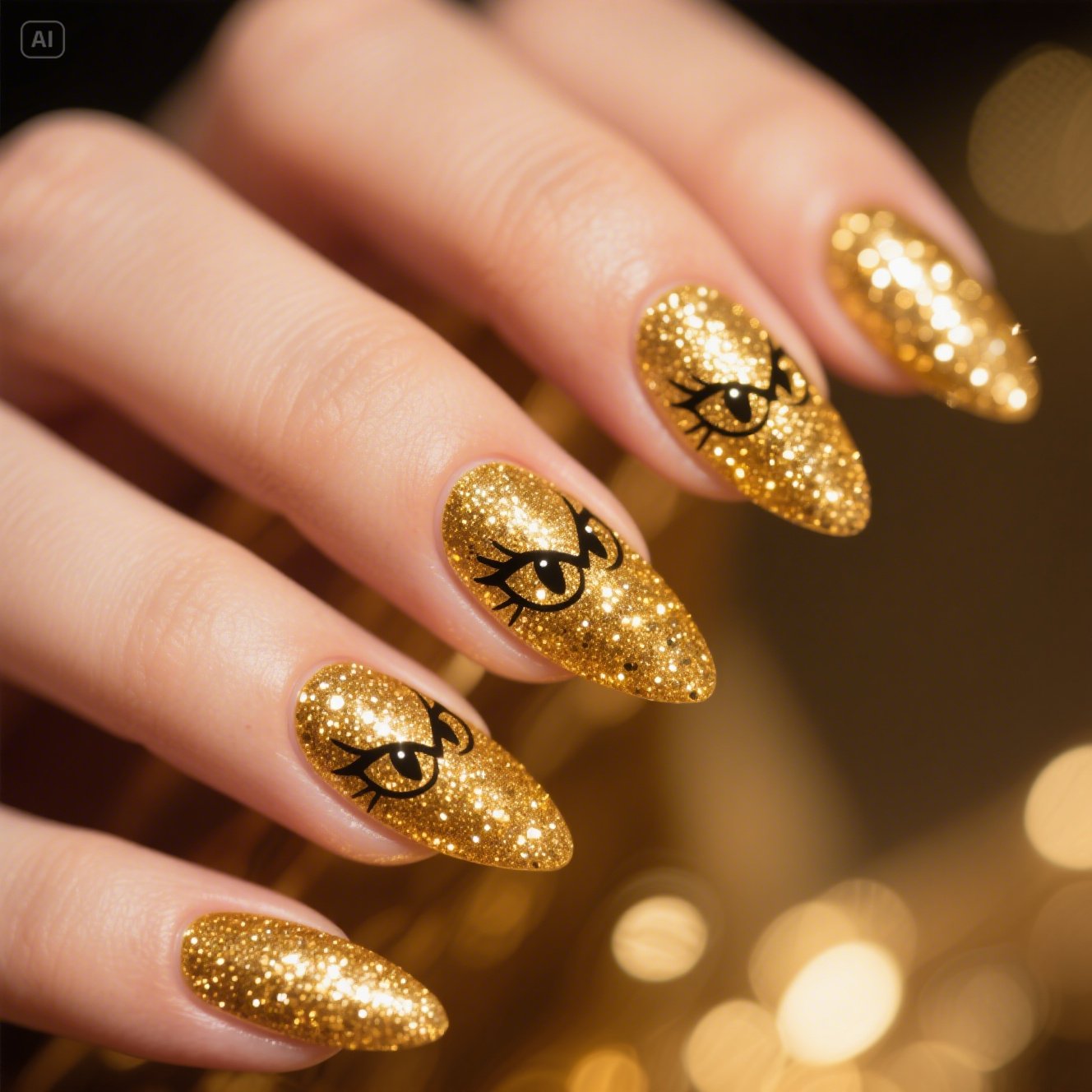15 Awesome Earthy Bathroom Ideas You Have to See
Earthy bathrooms calm the mind the moment you step in. Think of spa vibes, but warmer and more human. The secret is simple: nature. When you bring in stone, wood, and clay tones, the room feels grounded and safe. Soft textures and warm light add comfort, while plants and natural scents create a mini retreat at home. You don’t need a full remodel to get there. A few smart swaps—like a linen curtain, a wood stool, or terracotta accents—can shift the space fast. In this guide, you’ll see 28 practical ideas, plus tips to mix and match them without stress or a huge budget.
Core Elements of Earthy Style (Colors, Textures, Light)
Start with color. Earth tones like sand, taupe, clay, olive, and charcoal create a gentle base. Then layer textures: raw woods, woven baskets, matte ceramics, and stone. These surfaces reflect light differently, adding depth without busy patterns. Speaking of light, try to keep it warm and soft. If you have a window, use sheer coverings to filter daylight. At night, mix ceiling light with a sconce or two for a cozy glow. Keep lines simple and shapes organic. The result feels calm, not cluttered—like a quiet cabin morning rather than a sleek showroom.
Natural Materials You Can Trust (Stone, Wood, Clay)
When choosing materials, think long-term. Stone is tough and timeless; granite, slate, and river rock all fit the earthy mood. Wood brings warmth—especially oak, teak, or cedar—and can be sealed for moist spaces. Clay-based finishes like tadelakt or Venetian plaster add soft texture and a handmade look. Ceramics—sinks, jars, and tiles—are durable and easy to clean. Choose matte or honed finishes over glossy ones to keep the look natural. Use metals as accents only: aged brass or black iron work well. With these basics, any combination will feel grounded and balanced.
Budget Tips to Get the Look Without Overspending
You don’t need luxury stone slabs to nail this style. Mix high and low. Try porcelain that looks like stone, or a wood-look tile if real wood won’t work. Use reclaimed pieces—old ladders, stools, or crates—for character and storage. Swap small hardware first: drawer pulls, hooks, and towel bars in matte black or brass change the tone fast. Paint is your budget hero: choose a warm neutral and repaint the room in an afternoon. Add a couple of plants, a woven basket, and a linen curtain. Small, smart moves add up to big earthy energy.
Check Also : 15 Amazing Ideas for Spring Private Decks
River-Stone Shower Floor
A river-stone (pebble) shower floor brings the outdoors under your feet. The rounded stones massage your soles and add traction, which helps with safety. Choose mesh-mounted pebble sheets for easier installation and a flatter finish. Keep grout lines small and use a high-quality sealer to prevent soap scum buildup. Pair the floor with plain, large-format wall tiles so the pebbles stand out. A teak bath mat outside the shower keeps the zone cohesive. Maintain it by squeegeeing after showers and deep-cleaning monthly with a stone-safe cleaner. The look is spa-like, grounded, and timeless.
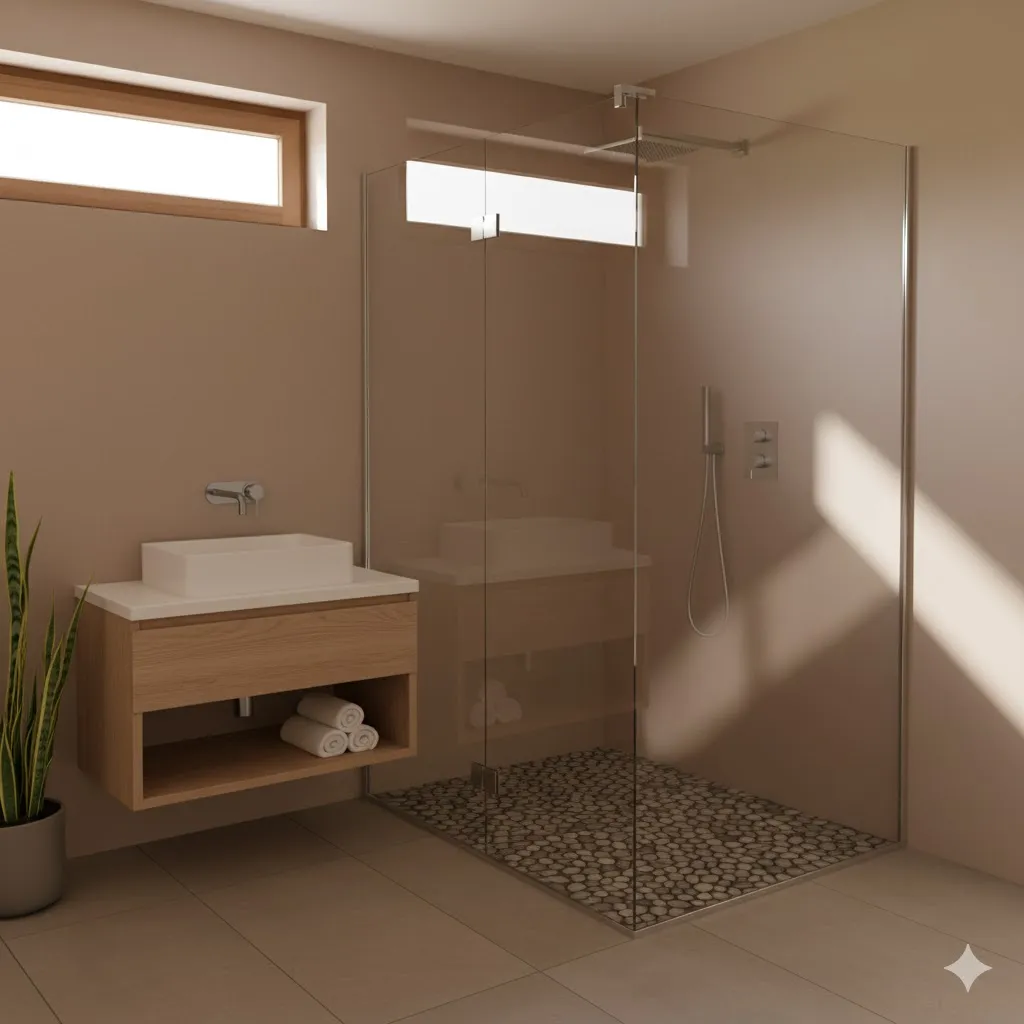
Tadelakt or Micro cement Walls
Tadelakt, a traditional lime plaster, and microcement both deliver soft, seamless walls with subtle movement. They’re great for creating a cave-like calm without tile grout lines. Professional installation is wise for wet areas, but you can DIY a feature wall. The result is tactile and warm, especially in clay, sand, or mushroom hues. Pair with minimalist fixtures and a simple mirror to let the texture shine. These finishes are breathable and can be sealed to resist moisture. Clean gently with pH-neutral products. If you want a luxury spa feel without shiny surfaces, this is a beautiful route.
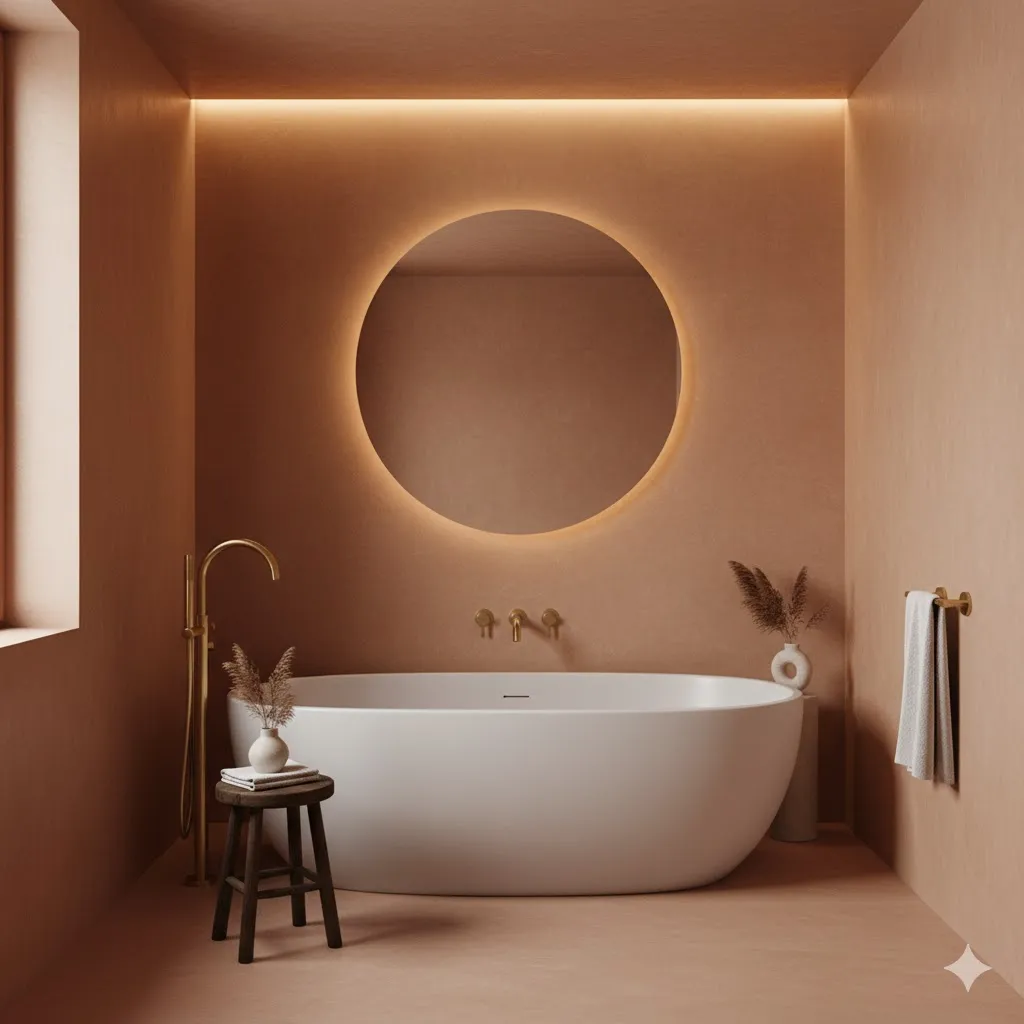
Reclaimed Wood Vanity
A reclaimed wood vanity adds soul in seconds. The aged grain and knots tell a story—and they contrast beautifully with smooth sinks and metal taps. Look for solid wood (oak, elm, or teak) and seal it well to handle splashes. Pair with a simple ceramic or stone vessel sink for a balanced mix of rough and refined. Open shelving underneath keeps it light and airy. Style with woven baskets, rolled towels, and a small plant. This one piece can set the whole tone of the bathroom and make it feel warm, lived-in, and welcoming.
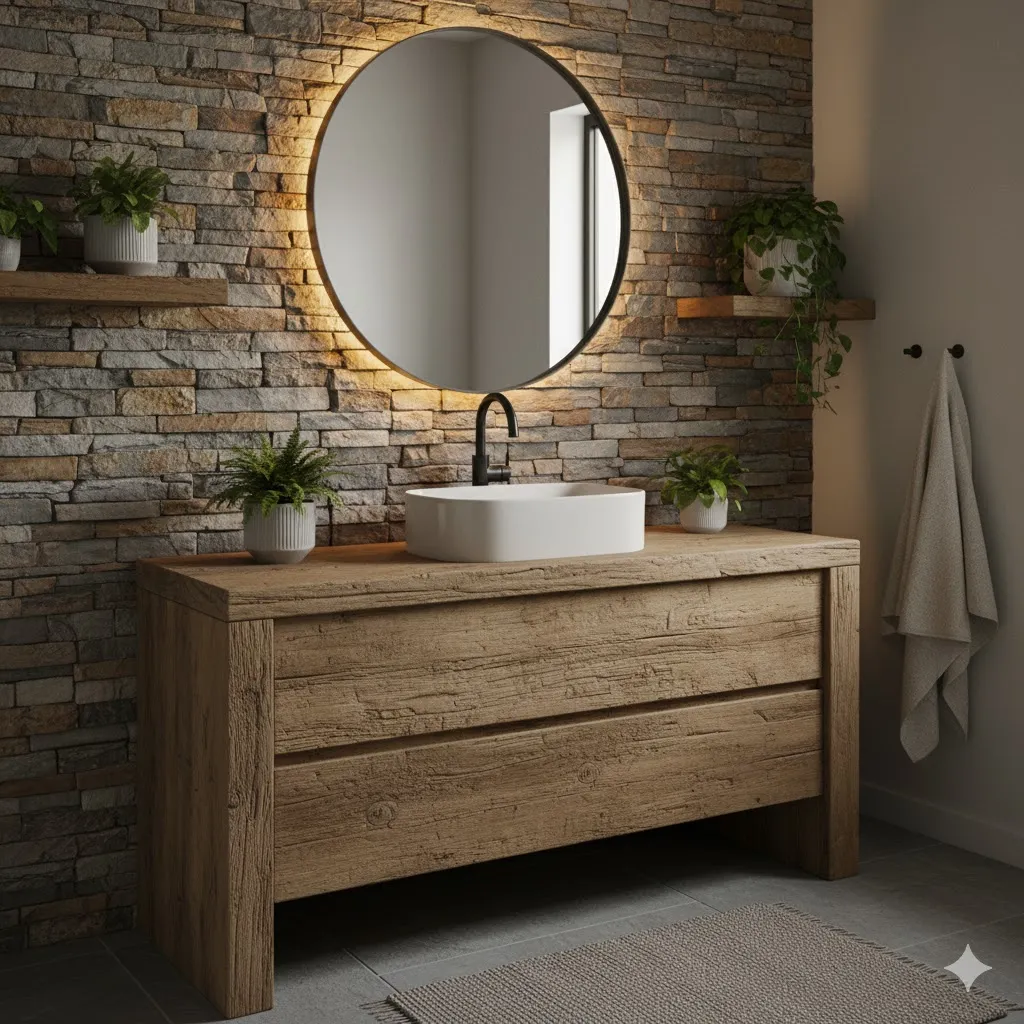
Terracotta Tile Accents
Terracotta brings sun-baked warmth to floors, niches, or a single accent wall. Choose sealed, low-maintenance terracotta or a porcelain lookalike if you want easy care. The earthy orange pairs well with off-white walls, olive textiles, and black fixtures. Keep tile layout simple—stacked or basic brick—to let the color and texture lead. Terracotta looks great next to linen and rattan; add a woven hamper or tray for harmony. Clean with mild soap and reseal as needed. Even a narrow terracotta border or niche lip can make a small bath feel rich and grounded.
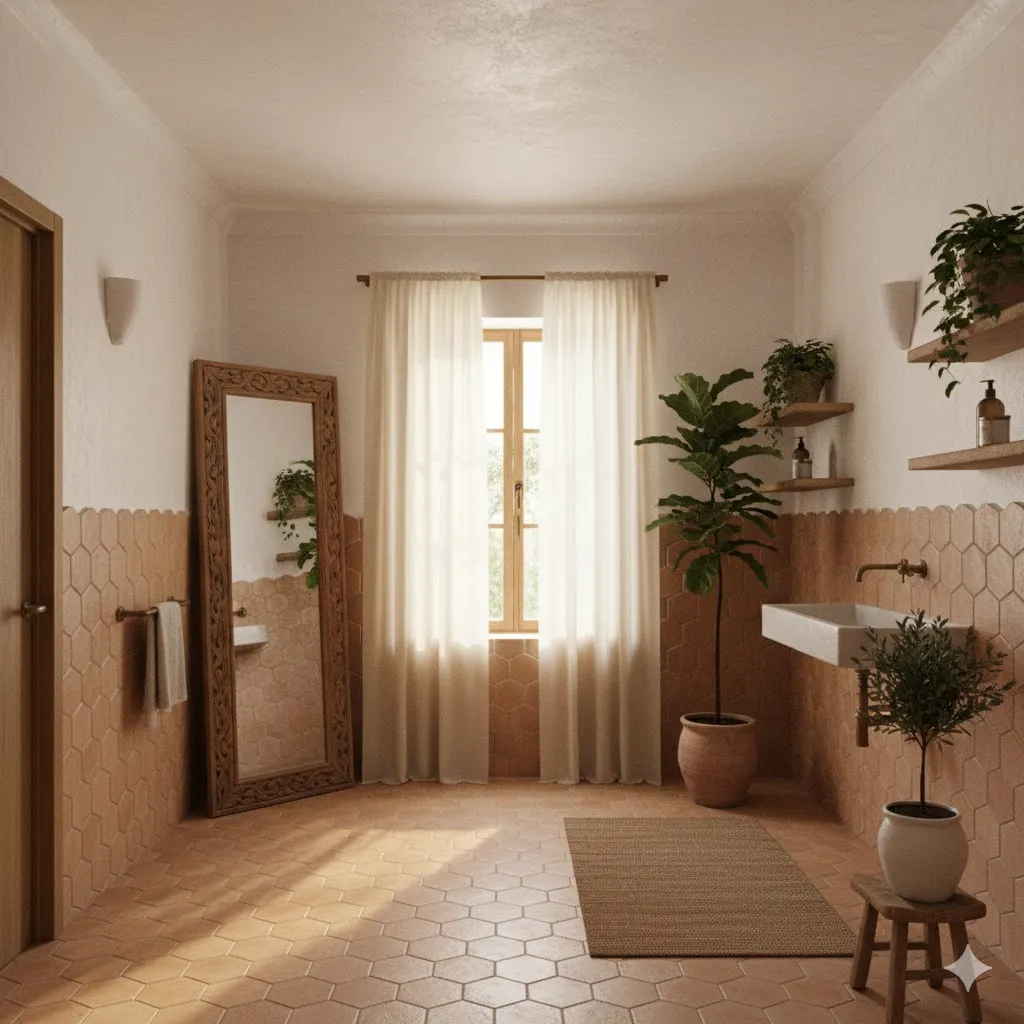
Matte Black and Aged Brass Fixtures
Metal finishes set the mood. Matte black gives a modern, graphic edge; aged brass adds warmth and classic charm. Mix them, but do it with intent: for example, black taps with brass pulls and a brass-framed mirror. Keep the rest of the room natural so the metals highlight shapes rather than scream for attention. Choose simple, solid forms that feel timeless. If you’re replacing fixtures, start with the faucet and shower kit, then match towel bars and hooks. These small changes bring a cohesive look and complement stone, wood, and clay beautifully.
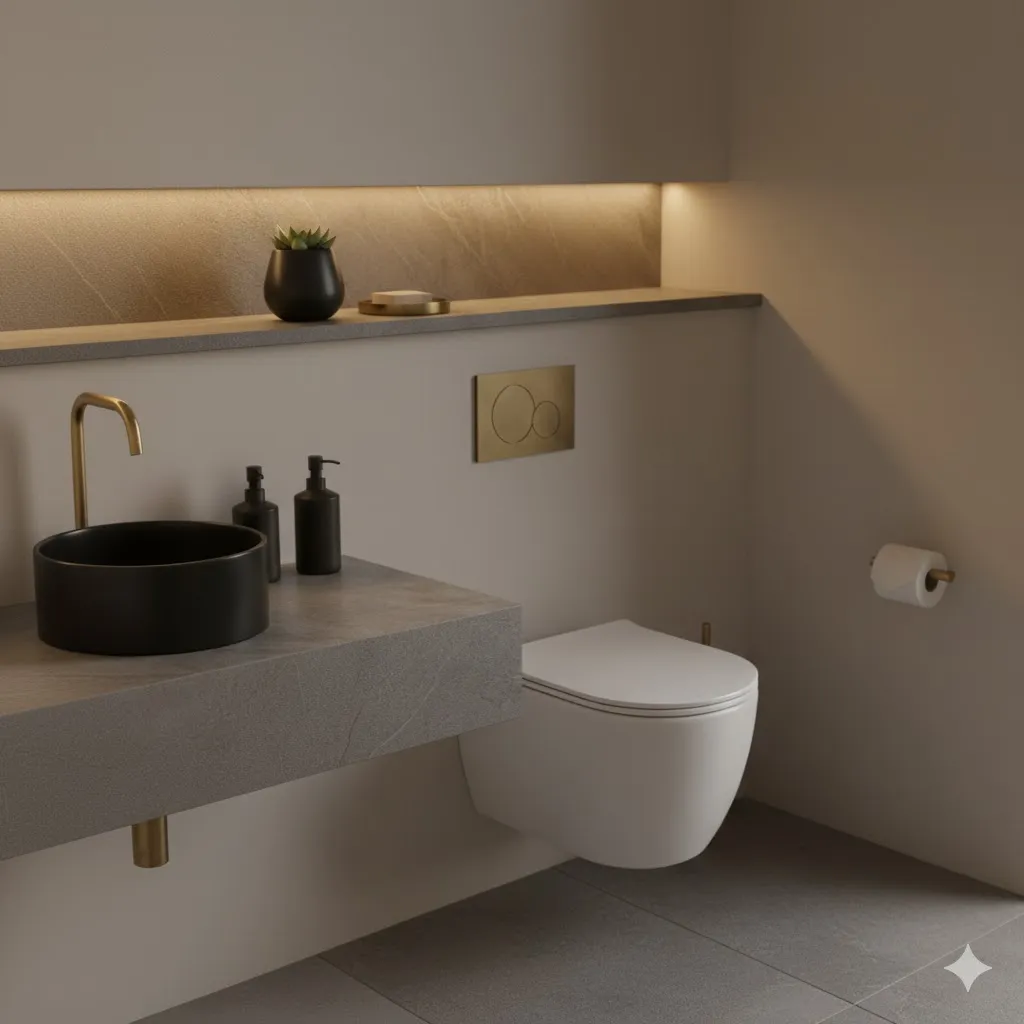
Bamboo or Rattan Storage
Bamboo and rattan storage pieces keep the vibe relaxed and airy. Use lidded baskets for toilet paper, open trays for daily essentials, and a rattan shelf or cart for towels. The woven texture softens sharp lines and adds visual warmth. Choose pieces with a protective finish to handle humidity. Pair with linen or cotton bins in sandy colors for a neat, layered look. If space is tight, use vertical storage: a slim rattan tower or wall-mounted bamboo shelves. These materials are light, renewable, and easy to style with almost any earthy palette.

Linen Shower Curtain and Towels
Textiles make a huge difference. A linen shower curtain drapes softly and lets light pass through, so the room feels larger. Choose natural or warm-toned linen—oat, flax, or clay—to match your palette. For towels, go with thick cotton or linen blends in solid earth tones. Avoid heavy patterns; let texture do the talking. Wash with gentle detergent to keep fibers strong and soft. Add a simple wood or bamboo rod and matte hooks to finish the look. This quick swap costs little but adds instant spa energy and tactile comfort you’ll notice daily.
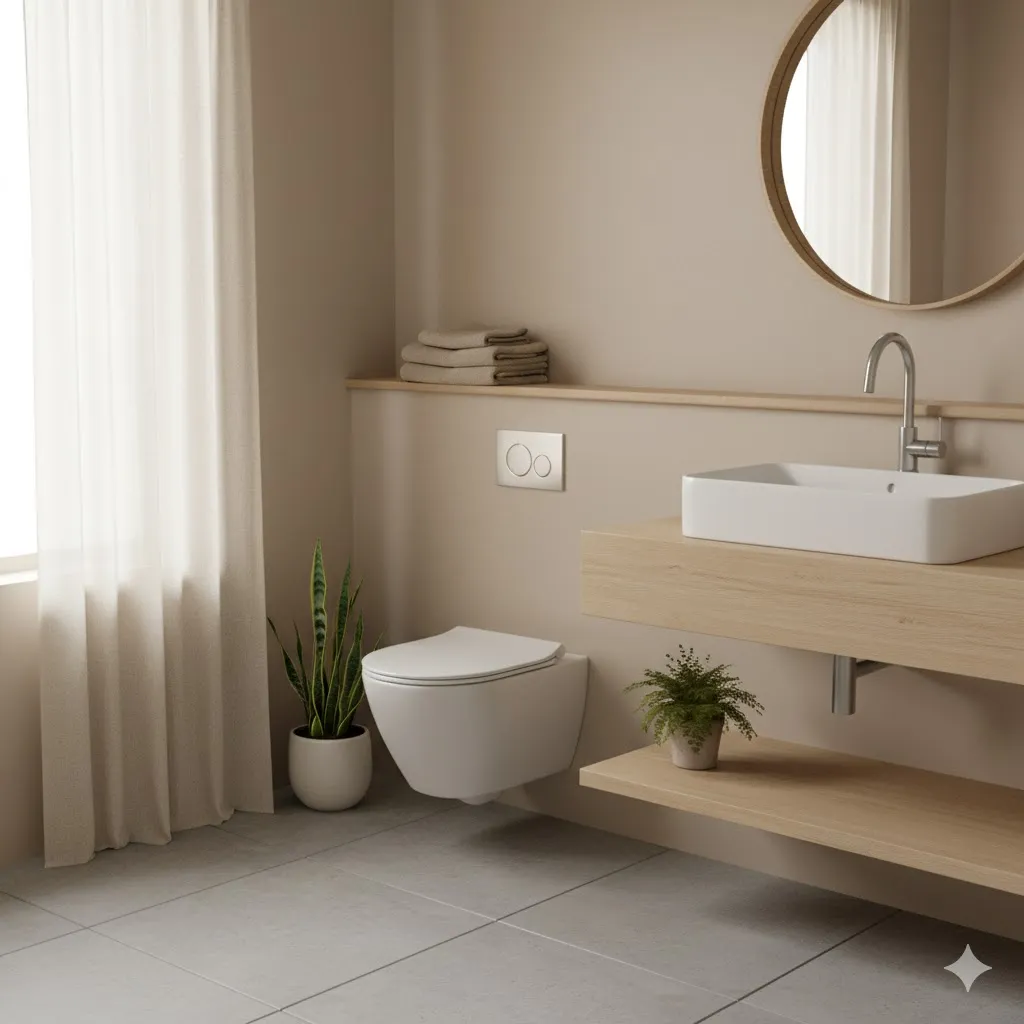
Pebble-Embedded Bath Mat
A pebble-embedded mat brings the river-stone vibe outside the shower. You can buy one or DIY by gluing flat pebbles to a rubber mat and sealing it. The texture massages your feet and carries the earthy theme across the room. Place it where water drips off—near the shower or tub—to keep floors dry. Pair with a second soft rug by the vanity for warmth. Clean by rinsing and air-drying; scrub gently when needed. This small, tactile detail helps connect the larger elements and makes the daily routine feel more mindful and grounded.

Live Plants That Love Humidity
Plants complete the earthy story. Pick humidity-loving types like pothos, ferns, philodendron, and peace lily. Place them on a windowsill, a high shelf, or a hanging planter to save counter space. Use terracotta or stone pots for texture and drainage. If light is low, consider a small grow bulb inside a sconce or use hardy varieties like ZZ or snake plant. Water regularly but avoid soggy soil; the bathroom’s humidity helps. Plants purify air, add color, and make the room feel alive. Even two or three can change the mood from plain to serene.

Clay or Ceramic Sink Basin
A clay or ceramic vessel sink adds soft curves and handcrafted character. Choose matte, speckled glazes in sand or stone hues for an organic feel. Pair with a simple wall-mount or deck-mount tap in brass or black. Vessel sinks look great on reclaimed wood or honed stone counters. Keep the backsplash simple to let the bowl shine. Clean with gentle soap to protect the finish. This one upgrade creates a focal point and nods to traditional forms, blending beautifully with woven textures and natural tiles elsewhere in the room.

Warm, Earth-Toned Paint Palette
Paint is the fastest transformation. Choose warm neutrals like mushroom, taupe, greige, or clay pink. Test large swatches on different walls; light changes everything. Aim for a matte or eggshell finish to hide small flaws and keep the look soft. Pair with white ceilings for lift or continue the color onto the ceiling for a cocoon effect in small spaces. Keep trims subtle—off-white or a shade darker than the wall—for a tailored finish. With paint alone, you set the earthy mood and make every natural accent feel intentional.
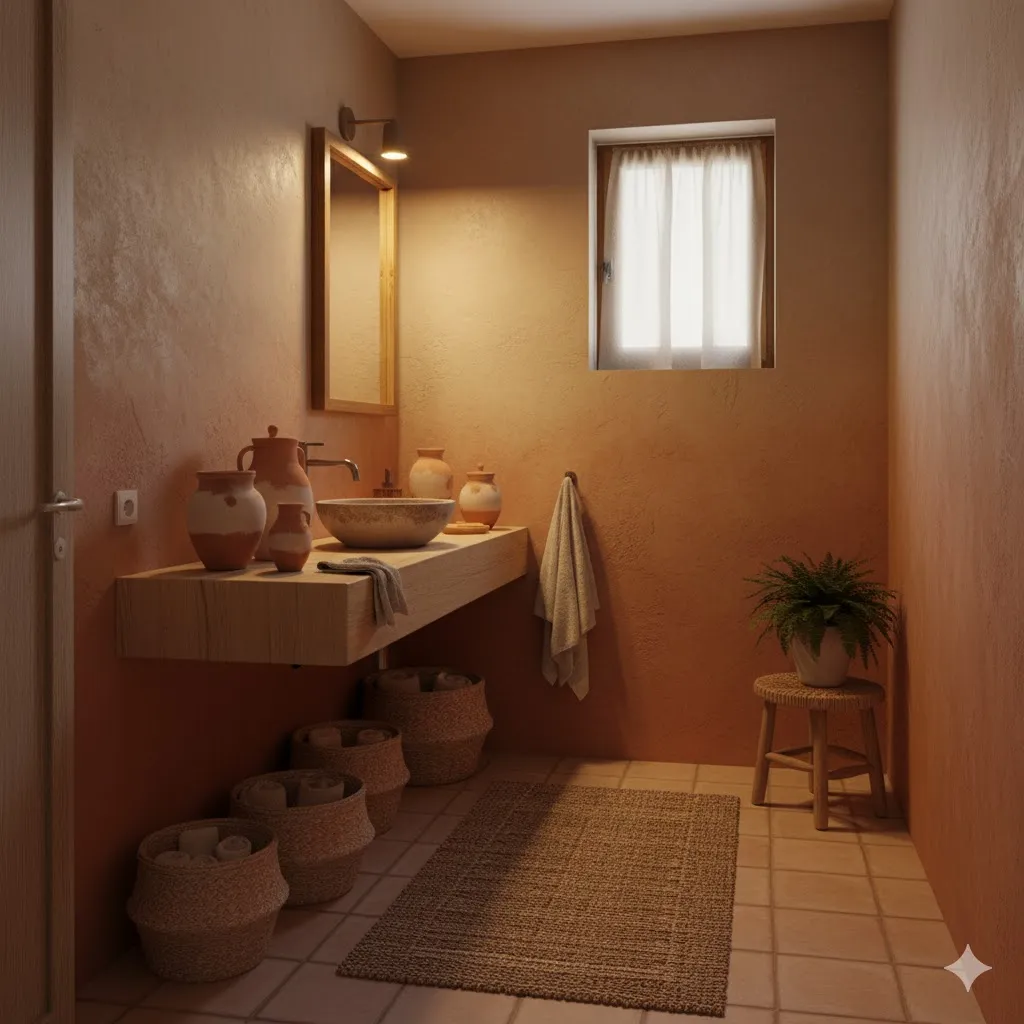
Organic-Shaped Mirror
An organic, irregular mirror breaks up straight tile lines and adds a sculptural touch. Look for pebble, oval, or freeform shapes with a thin black or brass frame. Place it above a simple vanity so the mirror becomes the star. Good mirrors bounce light and make small rooms feel bigger. If you can, add a dimmable sconce on each side for even face lighting. Keep the counter styling minimal—just a ceramic jar and a plant—so the mirror’s shape reads clearly. It’s a small design move with big visual payoff.
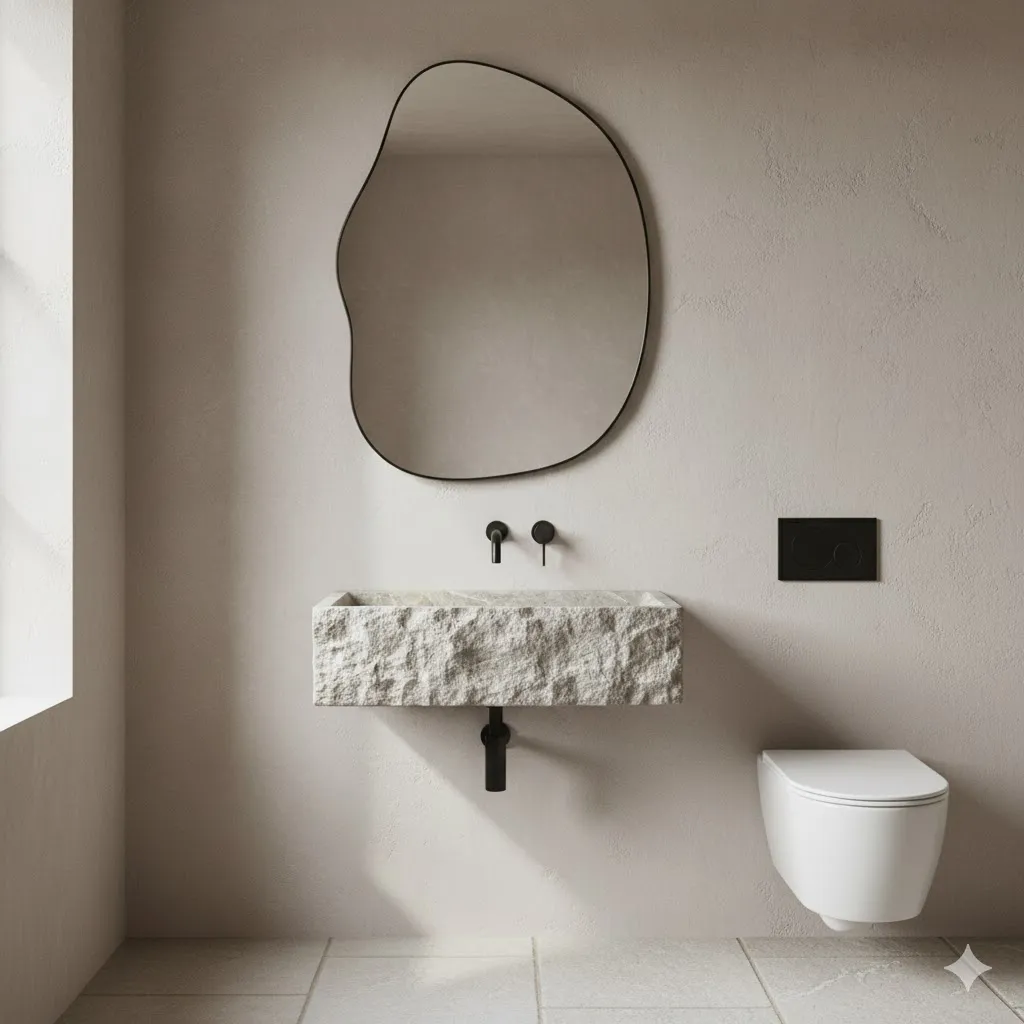
Rough-Cut Stone Countertop
A honed or leathered stone counter—granite, soapstone, or quartzite—brings tactile richness. The matte finish hides water spots better than polished surfaces. Pair it with a simple undermount sink and restrained hardware. Keep the backsplash quiet—microcement, limewash, or plain tile—to let the stone’s character lead. Seal the surface regularly for stain resistance, and wipe spills promptly. If a full slab is pricey, consider a stone remnant for a powder room or a narrow vanity. The result feels solid and rooted, like you brought a piece of the landscape indoors.
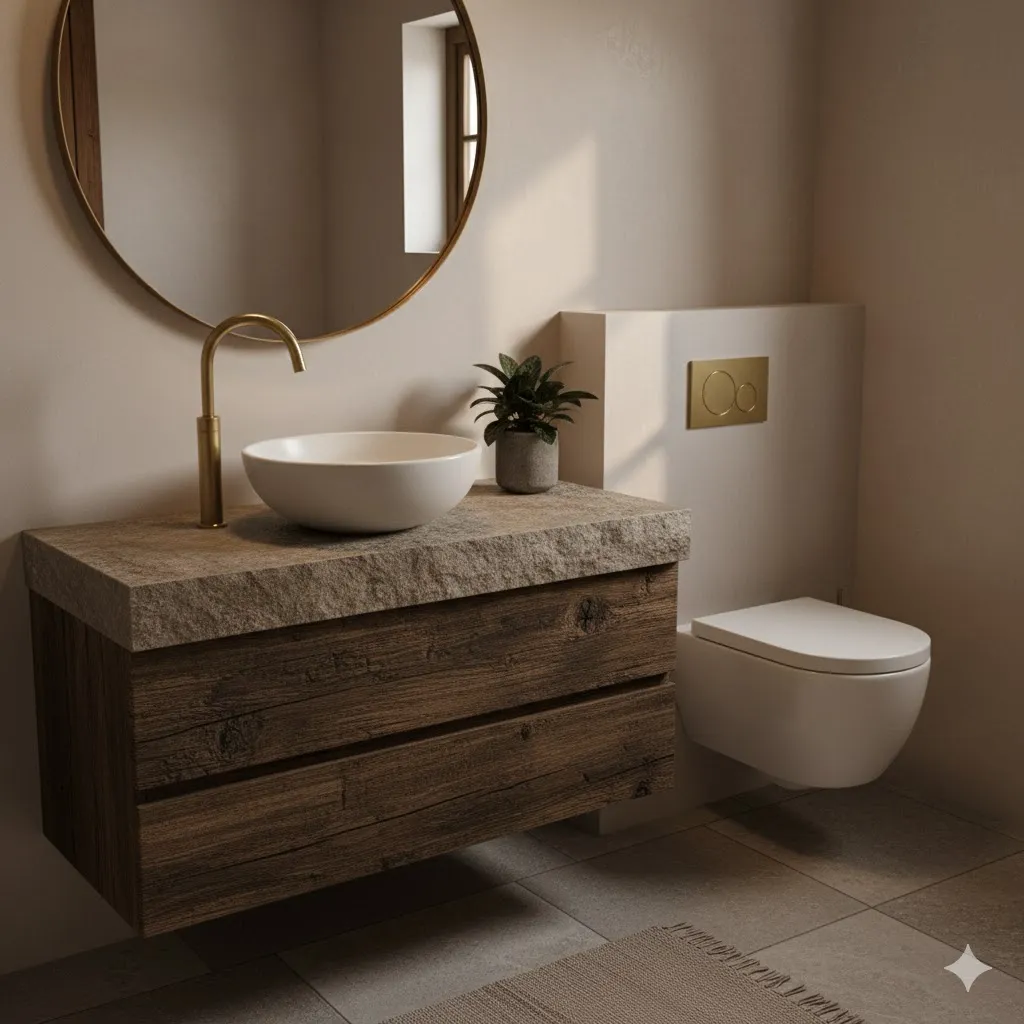
River-Reed or Grasscloth Wallpaper (Moisture-Safe)
Textured wallpaper in a reed or grass look adds depth and warmth. For bathrooms, choose vinyl-backed or moisture-rated options that mimic the natural weave. Use it on a single wall or above beadboard to control cost. The subtle linear texture pairs beautifully with stone and wood, adding a gentle rhythm to the room. Keep art simple—one framed botanical print is enough. Clean with a soft cloth; avoid harsh scrubs. This approach delivers that earthy, layered look without heavy materials, perfect for renters or quick weekend refreshes.

Wooden Bath Caddy and Stools
A wooden bath caddy across the tub and a small stool by the shower bring practical comfort. Teak and cedar handle humidity well and develop a lovely patina over time. Use the caddy for a candle, book, or soap dishes in ceramic. The stool doubles as a plant stand or a spot for towels. Keep the shapes simple and the finish matte. These pieces make the room feel like a spa, encourage slow moments, and add that essential wood touch that balances stone and tile textures.
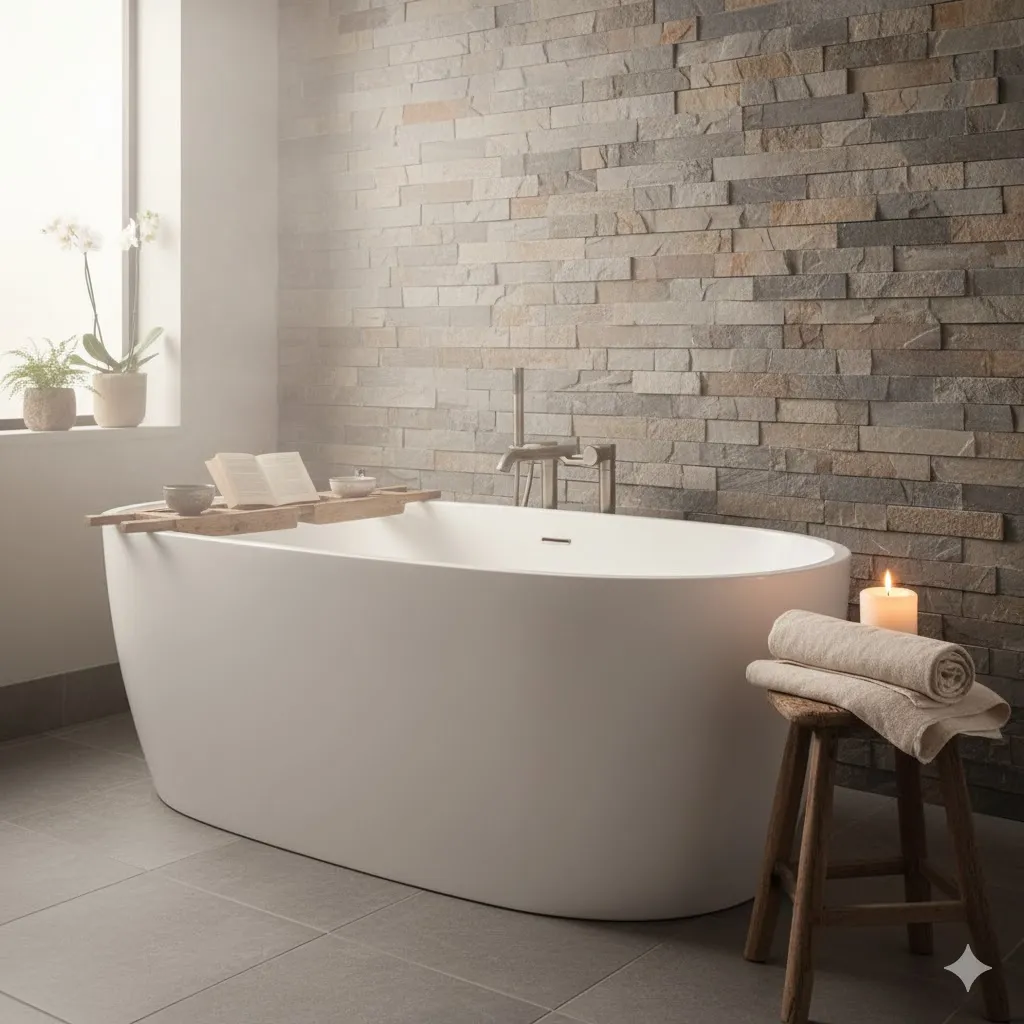
Pulling It All Together: A Simple Step-by-Step Plan
First, define your palette: pick two main colors (say, warm taupe and off-white) and one accent (olive or rust). Second, choose a hero material—stone floor, wood vanity, or clay walls. Third, layer textures: linen curtain, woven storage, matte ceramics. Fourth, add a plant and an organic-shaped mirror to soften lines. Fifth, finish with scent and warm lighting. If budget is tight, start with paint, textiles, and hardware, then upgrade one surface later. Take your time; the earthy look loves slow, thoughtful changes. Your bathroom will evolve into a calm, grounded retreat.
Maintenance and Care for Natural Finishes
Natural materials reward gentle care. Use pH-neutral cleaners on stone, avoid harsh scrubs on plaster, and reseal wood and stone as recommended. Ventilate after showers to protect walls and ceilings. Shake out rugs and wash textiles regularly to keep them fresh. Wipe standing water from counters and tub edges to prevent marks. Dust plants and check for overwatering. Small, regular habits beat big deep cleans. When you treat materials kindly, they age with grace—gaining patina, not damage—and your bathroom keeps its calm, earthy beauty for years.
Conclusion
Earthy bathrooms are about honest materials, soft light, and simple comfort. You don’t need a big budget or a full remodel. Start with a few ideas—maybe a linen curtain, a bamboo shelf, and a clay-hued wall—and build from there. Mix textures, keep colors warm, and let nature lead the way. Each choice adds up to a room that slows you down, centers you, and feels good every day. Use these 28 ideas as a menu, not a rulebook, and create a space that fits your home, your routine, and your sense of calm.
FAQs
- What colors work best for an earthy bathroom?
Go for warm neutrals like sand, taupe, mushroom, clay pink, olive, and charcoal. Keep the palette tight—two mains and one accent—so textures can shine. - Can I make an earthy bathroom on a small budget?
Yes. Start with paint, textiles (linen curtain, towels), and hardware (black or brass). Add a plant and a woven basket. Upgrade surfaces later. - Are wood elements safe in bathrooms?
They are if sealed and ventilated. Use moisture-resistant species like teak or cedar, and wipe splashes. Consider engineered wood or wood-look tile in high-splash zones. - Which plants survive in low light?
Try ZZ plant, snake plant, or pothos. If you have some light and humidity, ferns and peace lilies thrive. Use terracotta pots with saucers for drainage. - How do I keep stone looking good?
Seal it as directed, clean with pH-neutral products, and wipe water after use. Avoid acidic cleaners. Honed or leathered finishes hide spots better than polished.

